The kitchen sink is used for a variety of tasks and activities. Kansas State University food scientist Karen Blakeslee says preventing bacteria that causes foodborne illness is especially important in the kitchen sink.
“We use the kitchen sink for food preparation and more,” Blakeslee said. “The possibility exists for foodborne illness-causing bacteria to hang out in the sink too. These bacteria could cross-contaminate your food and make you sick.”
Blakeslee added that a recent U.S. Department of Agriculture study tested surfaces where participants prepared a breakfast meal with raw sausage, shell eggs, and a fruit salad made with cut-up cantaloupe. Test results showed that 34% of the sinks were contaminated after preparing their meal.

Even more scary, 26% of the samples of cut-up cantaloupe from the fruit salad were contaminated after breakfast prep.
“The bacteria in the sink or on your hands can cross-contaminate from the sink to other items, including those you normally eat raw. This means you’ll be eating that bacteria too,” Blakeslee said.
After using your sink to wash or prepare food, clean and sanitize the sink:
1. Use warm, soapy water to wash the sink. Wipe it clean with paper towels.
2. Use a sanitizer and let air dry. Sanitizers can be homemade—1 tablespoon of liquid chlorine bleach per gallon of water—or use a commercial sanitizer or sanitizing wipe.




